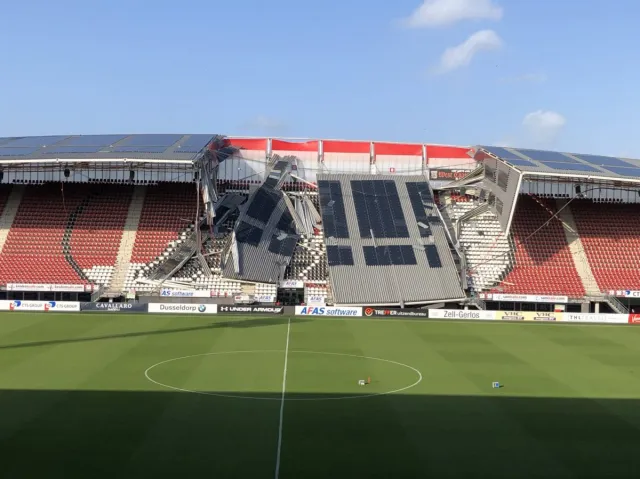The bearable lightness of solar
Aug 12, 2019 11:28 PM ET
- The weight of a thin-film rooftop PV installation at Netherlands football club AZ Alkmaar has been highlighted in media reports as a possible cause of a stadium roof collapse. However, a full investigation is yet to be launched and one German specialist said studies have shown flush-mount PV panels do not increase static wind loads on rooftops.

The news has been plastered across Netherlands and international media and has caused a sensation. A large portion of the roof on one stand at football club AZ Alkmaar’s stadium collapsed on Saturday as strong winds hit the city of Alkmaar.
Fortunately the stadium was empty at the time as the football team were playing on the road at RKC Waalwijk and nobody was hurt. The team’s general manager Robert Eenhoorn announced a thorough investigation of the matter has been launched, and it was too early to say what may have caused the collapse.
The weight of a Hanergy thin film rooftop solar system on top of the stand may have been a factor in the incident, according to Andries Broersma, owner of Ingenieursbureau Broersma BV and chief engineer for the design of the 2006-built stadium. Broersma told Dutch national TV channel NOS the incident may have been caused by a combination of factors also including poorly attached steel pipes and strong winds.
“It is strange that AZ Alkmaar has laid the solar panels without asking us if the roof could handle it,” the engineer said, referring to the fact the Hanergy system was installed in 2015, almost a decade after the stadium was built.
Solar unlikely to be the cause
Thorsten Kray, head of the PV wind loading department at Germany’s Institut für Industrieaerodynamik GmbH, took a different view.
“I have had a quick look on the news feed,” he told pv magazine. “And, I absolutely do not believe that the solar panels are the root cause of the wind-related failure. If the structural design calculations were carried out properly, [and] taking the dead load of the solar panels into account, PV panels cannot be considered the cause.”
Kray cited numerous scientific publications about flush-mounted PV panels which demonstrate roof-parallel solar does not increase static wind load on rooftops.
“Such grandstand roofs as the Alkmaar [stadium] are likely to be prone to resonant dynamic wind effects and [are] usually subject to wind tunnel study, in a boundary layer wind tunnel,” said the expert. “If I was in charge with this investigation, I would check on this first.”
Kary said, theoretically the mass of the solar panels would change the normal frequencies of the structure affecting the dynamic wind load of the roof, adding: “However, this is something that should have been checked when adding the solar panels to the roof, which typically would be the responsibility of the structural engineer in charge for the stadium roof. In brief, somebody must have given permission to add the solar panels to the roof and that person certainly was not the mounting system manufacturer, installer or EPC [engineering, procurement and construction services provider]. The flaw must have been on the stadium owner’s side, e.g. by a non-state-of-the-art structural roof design.”
Also read
- UbiQD Secures Landmark Quantum Dot Deal with First Solar
- Astronergy Invests $53M in Tandem Solar Cell Project
- ARENA Unveils $39M Solar Innovation Funding Round
- CNNP Optoelectronics brings utility-scale perovskite modules out of the lab
- Low-Temperature Sequential Deposition Lifts Inverted Perovskite Solar Cells Efficiency Record
